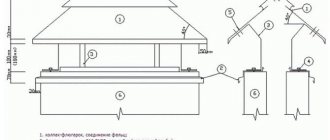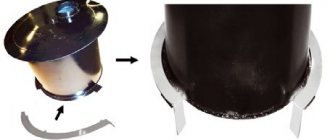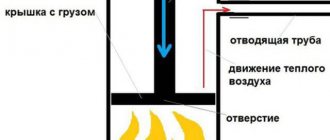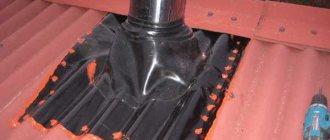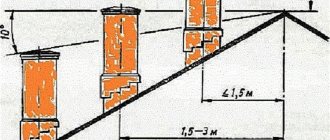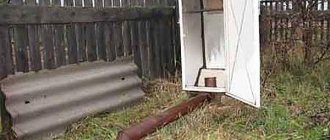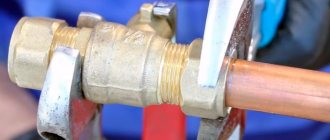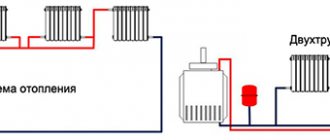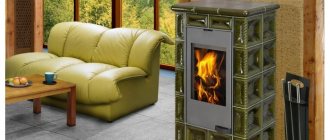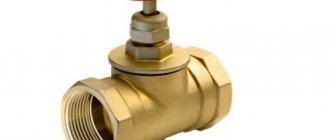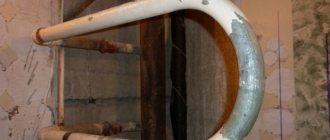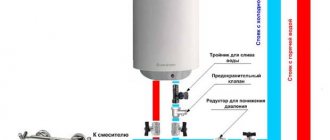Properties and features of ceramic pipes
Ceramic products have properties that set them apart from all pipes used in chimney systems:
- ease of operation. Thanks to the smooth walls of the pipe, fumes and layers of soot do not accumulate inside it, which eliminates the unnecessary hassle of maintenance;
- durability. Such a pipe can last more than 30 years, as it is resistant to corrosion and sudden temperature changes. This effect is achieved by treating the product with expanded clay concrete mixture or a special composition of mirror steel;
- resistance to mechanical damage;
- ease of processing. Ceramic pipe is easy to cut and drill, and the quality of the product does not suffer;
- absolute waterproofness;
- immunity to chemicals. This product is not afraid of fluoride compounds, solvents, chlorine and other chemicals;
- safety. Another advantage of ceramic chimneys is fire resistance, so if soot ignites, the flame will not spread;
- accumulate heat well;
- ease of installation work, which reduces the likelihood of defects and errors;
- good traction due to smooth surface. You will not have problems such as smoke in the room;
- nice price. Ceramics is not a very expensive material; By purchasing such a chimney, you get an ideal price-quality ratio.
Ceramic pipes are one of the best materials for chimney installations
Design Features
A chimney based on a ceramic pipe is a three-layer structure:
- In the center there is a ceramic pipe, which is assembled from several cylinders with a diameter of 30 to 100 cm.
- The next layer of the chimney is thermal insulation, which protects surrounding objects from overheating due to the high thermal conductivity of ceramics.
- The outer layer is expanded clay concrete blocks that frame the pipe on all sides, forming a structure of rectangular cross-section. Inside, each block has a curved radius that matches the shape and size of the pipe.
The principle of installing a ceramic chimney is similar to the technology for installing a modern metal chimney lined with brickwork. The significant difference is the materials used. Ceramics differ from metal in physical, mechanical and reactive properties, which provide it with both advantages and disadvantages in operation.
Note! Unlike a metal chimney, a ceramic chimney requires the installation of a foundation. A heat-resistant ceramic pipe weighs several times more than a stainless steel pipe, and therefore it is not safe to rest directly on the outlet pipe of a fireplace or stove.
To ensure the stability of the heavy structure, a small concrete foundation up to 50 cm high is erected before installing the chimney.
We recommend that you read: How to properly install a ceiling-passage assembly for a chimney in a bathhouse
Helpful installation tips
One of the main rules for installing ceramic chimneys: only whole elements are suitable for installation. The presence of chips, cracks or any other damage is unacceptable. You should not try to repair the damaged area with sealant or anything similar.
This is a dangerous solution, since damage hidden inside the structure can fail at any time and cause a fire.
Therefore, each element must be checked at the time of purchase, as well as immediately before installation. If even minor damage is found, a replacement should be made. The base for the adapter must be perfectly flat and horizontal.
Maintenance of a ceramic chimney must be performed regularly twice a year: inspect, clean from soot and check the draft level
Maintenance of chimneys of this type is not difficult. It is necessary to check the presence of draft, clean the pipes of soot, and monitor the integrity of all structural elements.
Typically, these operations are performed twice a year, but if there is reason to doubt the normal functioning of the chimney, maintenance activities can be performed unscheduled. Although, if installed correctly, problems practically do not arise with such structures.
Requirements for ceramic chimneys
Apart from the foundation, most of the technical requirements for installing a ceramic chimney are practically no different from those for metal structures. The requirements relate to the installation method, insulation and arrangement of the outer part of the chimney, rising above the roof.
The key point in arranging a ceramic chimney is the correctly selected pipe thickness. It must correspond to the type of furnace equipment and operating temperature during operation.
Since ceramics tend to absorb and transfer large amounts of heat, when in contact with hot exhaust gases it will heat up to dangerous levels. Therefore, to comply with fire safety standards, you need to choose the appropriate thickness and diameter of the ceramic pipe.
It is advisable to use the chimney installation method recommended by the boiler manufacturer.
Insulation is another important point in arranging a ceramic chimney. Just like metal pipes, ceramics need insulation when passing through unheated rooms or when going outside. In places where the pipe passes through living spaces (room, kitchen), it is not necessary to insulate it.
Ordinary basalt or mineral wool and clinker brick can serve as insulation. This is a material that is optimal in cost and performance and is resistant to high temperatures.
In addition to fire safety, it is worth taking care of the main task of the chimney - good draft. This aerodynamic phenomenon largely depends on the correct placement of the pipe. As in the case of a metal chimney pipe, it is advisable to place the ceramic structure as close to the roof ridge as possible.
If this is not possible, the requirements for the height of the chimney head must be observed:
The pipe should not be lower than 30 cm if the pipe is relatively close to the ridge. When moving away from it by more than 1.5 m, the height should be increased to 50 cm.
If the distance between the ridge and the chimney is from 1.5 to 3 m, then its height must be designed in a special way. An imaginary horizontal line leading from the ridge to the roof arch at an angle of 10 degrees should run tangentially through the chimney cap.
Use of ceramic chimneys for baths and fireplaces
For baths and fireplaces, ceramic chimneys are primarily needed for convenient operation and aesthetics. It is worth understanding that due to modern heavy-duty boilers, the significant inertia of heat-intensive ceramics can become critical for their joint use.
But in a bathhouse this will be a plus, as well as in fireplaces, since they do not need to immediately switch to operating mode. When installed in a bathhouse, the ceramic chimney must be protected from high humidity, since lightweight concrete absorbs moisture over time, thereby reducing the thermal insulation properties of it and basalt wool.
As for fireplaces, by definition they must have vertical chimneys that can be hidden in the wall. Therefore, the ceramic option will come in handy here.
Peculiarities
It is unreasonable to approach chimney pipes with the same standards as water, gas, or drainage pipes. None of these types of communications encounter the same heating as smoke ducts. Accordingly, the difference between the temperature of the moving gas flow and the temperature of the street air is also large. This automatically eliminates the idea of using polymeric materials and other easily flammable substances. But the thermal conductivity of the material used must be maximum so that it does not overheat.
A very important circumstance is protection from the wind. Even a chimney with a small height (5 m) experiences significant loads from the movement of air masses
And the windage of taller structures increases as they “grow” in arithmetic progression. This means that among fireproof materials you will have to choose only those that are highly durable. But strong structures have a significant mass, and they will have to be secured thoroughly.
bd55b70eb5eb64ebb18ba85807f1d171.jpe
Of the other nuances that will have to be taken into account when choosing and installing, special attention is paid to:
- construction time and its complexity;
- geometry of the chimney channel;
- composition of flue gases, their quantity, speed and heating;
- intensity of use of the boiler (furnace);
- the cost of the design used;
- the need to attract specialists or the ability to do without them.
Building a chimney for a barbecue
In a country house, the question may arise with the construction, choice of materials and size for the chimney not only for the fireplace, but also for the barbecue. The construction of a chimney must be thought out; the first stage will always be a drawing of its plan on paper.
The simplest solution for building a chimney for a barbecue is to use cement mortar and reinforcing metal bars. The chimney frame is bent and then welded from metal rods. The metal frame is cemented and wrapped in mesh. The solution is applied to the rods from the inside and outside. After the cement mortar has hardened, the chimney is coated from the inside with refractory clay. The arch is formed after the solution hardens in the chimney; it requires a plywood template.
The drying time for the cement mortar used in the construction of a barbecue and a chimney for it is 3-4 days. Until this time, you cannot light a fire in the firebox, otherwise the walls of the structure will crack and the barbecue will be unsuitable for further use.
The question of how to make a chimney for a fireplace is decided with mandatory consideration of all technology and safety requirements. If they are violated, not only the efficiency of the fireplace is at risk, but also the livelihoods of all people in the heated room. Therefore, the best option for those who do not have proper experience in constructing such structures is to contact specialists proven in this matter.
No. 4. Chimney made of asbestos-cement pipe
A couple of decades ago, asbestos-cement pipes were widely used to construct chimneys. Actually, they were not originally intended for such purposes, which is easy to see by studying their performance characteristics. The only advantage of the material is its low price, but there are much more disadvantages:
- the material can withstand temperatures up to 300C, and often this is not enough. Such a pipe can only be used at the maximum distance from the firebox, where the smoke passes through already cooled;
- Soot quickly accumulates on a rough surface, which tends to catch fire. But if a brick chimney can easily cope with this, then a chimney made from an asbestos-cement pipe can simply explode;
- instability to condensate, which contains aggressive chemicals. Moreover, condensate can be absorbed into the pipe, destroying it and worsening its appearance;
- heavy weight and difficult installation;
- leaking joints.
You can use an asbestos-cement pipe for a chimney only if you are sure that the installation will be done correctly, as well as if the chimney is regularly cleaned, but it is still better to pay attention to other options
Example of installation of a steel chimney
Before making a steel chimney for a fireplace, it is necessary to carry out some preparatory work. First you need to install a fireplace insert. If special legs are not provided, you should make such a support yourself from metal, fireclay brick, stone, etc. The distance from the firebox to the wall should be 150 mm, taking into account that the thickness of the thermal insulation layer will be 50 mm.
After the position of the firebox is determined, you should arm yourself with a plumb line and determine the axis of the exhaust of the firebox smoke collector. The axis of the fireplace chimney must completely coincide with it. Now you should note the projection of the firebox on the adjacent wall, as well as on the floor. If the firebox is located on a metal stand, the support should be coated with a layer of fireproof paint. You need to place pieces of brick under the legs of the support so that its position corresponds to the level of the floor covering. A good idea for such a support is legs, the length of which can be adjusted.
You can begin work on installing the chimney only after the firebox has been placed in its intended place, and its position has been carefully verified vertically and horizontally, and then fixed with a metal corner.
After the connection of the elements of the steel chimney for the fireplace is completed using sealant and rivets, the joint is wrapped with aluminum tape
Now you can begin installing the chimney. First, all internal seams of the chimney should be treated with sealant. Then they begin assembling its elements from bottom to top. A double layer of sealant is applied in a circle to the joints of individual chimney elements. First, the inner circuit is connected, and then the outer one. In this case, the upper element of the internal contour must fit inside the lower element, and not vice versa. This will prevent condensation from getting on the insulation. The outer contour is fixed with rivets, then the joints and rivets are sealed with aluminum tape. In this case, it is necessary to ensure that the joints of the chimney elements do not fall under the thickness of the ceiling.
Proper installation of the chimney deserves special attention. To fix the pipe, the outer contour is crimped with a special clamp, which is fixed with rivets. Then the clamp is secured to the ceiling using a special angle and mounting bolts. In this case, the main weight of the fireplace chimney should not fall on the base of the fireplace insert, but on the clamps and corners fixed to the ceilings.
After the connection of the elements of the steel chimney for the fireplace is completed using sealant and rivets, the joint is wrapped with aluminum tape
When attaching a steel chimney, you should take into account the possibility of thermal expansion of the metal when heated. To compensate for this process, a special flexible element should be installed at the bottom of the first section of the fireplace chimney. If such a part is missing, it is necessary to provide a backlash of approximately 1-1.5 cm when attaching the clamps to the corners in order to allow the structure to move during thermal expansion. If the chimney contour is rigidly fixed, then during operation the lower section of the structure will be squeezed down, which can lead to damage to the equipment.
As they say, it is better to see once than to hear a hundred times. Therefore, here is a video with useful tips from an experienced stove maker:
UNI system
The modern and very promising UNI system, regardless of the manufacturer, is installed based on fire safety rules.
Installation occurs from the base up, component by component. When properly assured, the inner tube of the upper lobe always fits inside the lower element.
When installing such a chimney for a bath, always keep in mind the possibility of shrinkage. Improper fixation to the ceiling or roof with low rigidity will in this case provoke damage and deformation of the entire chimney structure.
Ceramic chimney device
A ceramic chimney, as already mentioned, is a composite structure that includes:
- chimney duct made of ceramics;
- insulation layer or air gap;
- outer layer of expanded clay concrete.
Such a serious design is explained by a number of factors. Firstly, the ceramic pipe that forms the chimney channel is very fragile and needs support. Secondly, it has high thermal conductivity, which is why it requires reliable thermal insulation.
The pipe itself is made of a circular cross-section, ranging from 30 cm to 1 m in length. Its internal walls are smooth, while the external walls may have roughness and minor defects that do not affect the integrity of the structure. The pipes are connected by means of a lock, which is a thinning of the outer diameter at one end and an expansion of the inner diameter at the other.
It is extremely important that they dock strictly along one central axis
The outer shell is made of expanded clay concrete in the shape of a square with a radial cavity inside. The height of the block depends on the manufacturer, as does the shape of the internal cavity. It is also provided for either direct contact of the separate parts of the block with the pipe, or the presence of space for insulation, which is connected by means of metal jumpers. They are attached to the outer shell and create reliable support for the ceramic pipe.
In expanded clay concrete blocks, a prerequisite is the presence of a special hole for laying reinforcement, which allows for maximum strength and stability of the entire structure, which is especially important in the lower and upper parts of the chimney. For insulation, you can use a layer of basalt wool or an air gap
The latter is used in chimneys with reverse air supply into an insulated combustion chamber or in chimney systems with a maximum temperature of up to +450°C. If the temperature exceeds this figure or it is necessary to provide better thermal insulation, use basalt wool, which is sold in the form of dense pressed slabs, along which grooves are made so that they can be rolled up
For insulation, you can use a layer of basalt wool or an air gap. The latter is used in chimneys with reverse air supply into an insulated combustion chamber or in chimney systems with a maximum temperature of up to +450°C. If the temperature exceeds this figure or it is necessary to provide better thermal insulation, use basalt wool, which is sold in the form of dense pressed slabs, along which grooves are made so that they can be rolled up.
Ceramic chimneys: advantages and disadvantages
Why brick chimneys are losing popularity
The most common types of chimneys in our country are brick. In simple words, it is a pipe made of brick. Then it is simply plastered. However, this pipe has a large number of disadvantages. Thus, the structure of the brickwork makes it difficult for the free passage of air flows, which is why the system loses traction, which is especially noticeable when heating devices operate in windy or cloudy weather.
Also, the heterogeneity of such a pipe, and we know that over time gaps can form between the bricks in the masonry, can cause a carbon monoxide leak, which usually leads to tragedy. Another disadvantage of brick chimneys is their heavy weight and difficulty of installation.
The brickwork for the chimney must have a massive foundation, as it weighs quite heavily. Installation of such a structure is usually carried out only by highly qualified masons. This type of work takes a lot of time. During operation, due to the rough structure of the chimney, soot can accumulate in it, especially from burning coal. A brick chimney must be constantly cleared of it, otherwise it can cause a fire, leading to a fire.
Recently, galvanized and ceramic systems have replaced brick chimneys. It is the latter that we will talk about next.
Advantages and disadvantages of ceramic chimneys
Ceramic pipes for the construction of a heating device chimney, be it a boiler, geyser or fireplace, began to be used in European countries quite a long time ago. In our country, the fashion for such systems came relatively recently. Compared to brick chimneys, such systems have a number of advantages:
Absolutely smooth inner surface of ceramic pipes. It is coated with a special fire-resistant glaze, making it completely smooth, which prevents the occurrence of turbulence and, as a result, improves traction. Long period between services. Such pipes do not need to be cleaned often, since practically no soot is formed on them. They, unlike brick chimneys, should not be coated with lime. High resistance to temperature changes
This property is especially important for solid fuel and combined boilers, in which fuel with different flue gas temperatures can be burned. Also, such units may not operate constantly, which causes frequent changes in chimney temperature. Ceramic pipes are not afraid of corrosion and other chemical reactions. High strength material. Easy to install
Chimneys made from ceramic pipes are quite quickly installed. Ceramics are easy to cut and polish well. Drilling a hole in such pipes is not difficult. All these factors significantly reduce the time and cost of installation of such chimney systems.
The only disadvantage we can highlight is their cost. However, taking into account the positive aspects that appear when using such chimneys, this disadvantage is leveled out. One of the most popular on the market are ceramic chimneys from Schiedel, which are distinguished by their durability and high performance characteristics.
How to make a chimney with a ceramic pipe with your own hands?
No private home can be imagined without a high-quality heating system. And no matter what it is based on - a good old tiled stove, a fireplace or a modern solid fuel boiler - in any case, you need to take care of the arrangement of the chimney, because combustion products must be removed outside the building.
Chimneys come in different types - brick, metal, ceramic, and their choice depends on many factors, from price to the design features of the structure, as well as the materials from which it is built. In recent years, chimneys based on a ceramic pipe have become increasingly popular. Today we will talk about them in more detail, describe all the advantages and disadvantages of the system, and also tell you how to make a ceramic chimney with your own hands.
Chimney installation
Installation work
Manufacturers produce a structure completely ready for assembly, it includes:
- ceramic blocks, including tees for cleaning and connection to the heating device;
- condensate container;
- frame made of blocks with holes for reinforcement;
- mineral insulation.
The top of the chimney is protected from precipitation by a special cone. A grille is installed at the bottom of the structure for air flow. When selecting the sequence of installation of modules and the size of the pipe, take into account that the joints of individual sections should not fall on the floor passages.
The significant weight of the chimney requires laying a separate foundation. Its dimensions exceed the diameter of the chimney by 10 cm in each direction. The concrete base must be level, its horizontalness is checked with a level. To ensure a level surface, you can lay porcelain tiles. The base of the pipe, especially those exceeding 7–8 m, must be set strictly at level. Next, waterproofing is performed using rolled material folded in two layers. The first concrete block is laid on the foundation, and cement mortar is used under it.
Using sealant when joining chimney pipes
A special sealant is used to connect sections of ceramic pipe. It is made independently from the dry mixture included in the kit and water, the ratio is maintained at 7:1. Mixing takes place in a warm room at +20 degrees; the composition must be used within 1–1.5 hours until it hardens.
A container for draining condensate is installed in the first block; a section of pipe with a hole for cleaning is attached to it using sealant. This module is wrapped in basalt wool. Each subsequent module is inserted into the previous one and secured with the prepared solution. Excess composition protruding onto the surface of the pipe is wiped off with a damp sponge. Outside the ceramic pipe there is a frame made of concrete blocks connected with cement-sand mortar. If necessary, holes are cut into them for individual tee sizes. The straight part is made from blocks without holes.
The third module is a tee for connecting a heating device. It is covered with a special front insert. After the straight section, a damper is installed.
The chimney can be used as a lightning rod
When installing blocks, it is important to maintain horizontal and vertical levels. To give the structure stability and rigidity, it is reinforced with iron rods
Holes were prepared in the corners of the blocks for metal reinforcement; 1.5 m sections were inserted into them and filled with cement mortar.
After installing the chimney, the inspection tee is closed with a door, and a ventilation grill is installed in the lower block. The air entering through it will move inside the channel and reduce the temperature. A ceramic chimney can be installed without a concrete frame, but in this case the pipe is secured with clamps every meter. In an unheated attic it is insulated with a layer of basalt wool.
The passages through the floor ceiling and attic are fenced with a box and insulated with basalt wool
Particular attention is paid to the safety of installing a ceramic chimney in a wooden house. Its location is provided 25 cm from the wooden wall
Completion of installation of a ceramic chimney
The final part of the chimney, located on the roof, ends with the installation of a concrete cover slab and a metal protective cone. The exterior decoration of the chimney is made of tiles or other material to the taste of the home owners.
Installation features
Installation of a ceramic chimney involves several important features. So, keep in mind that you will need to prepare a solid foundation. The “pillow” should be perfectly horizontal and level, without tilting or anything else.
Next, the main work plan:
- The required amount of solution is laid out on the finished “cushion”; in each individual case, calculate it yourself based on the weight of the structure and the diameter of the chimney. So, a module is installed on the solution, which can combine not only a connection pipe to the boiler, but also a special condensate receiver. By the way, do not forget to install a hatch for preventive cleaning with a “cesspool”.
- We are preparing a special solution on which the chimney will “sit.” Keep in mind that it must be resistant to acids. It is necessary to dilute the solution according to the manufacturer’s recommendations, but often rely on a similar calculation: 1 part water to 7 parts powder. In addition, remember that mixing must be done at a temperature not lower than 17-20 degrees, and the solution must be used within 1.5 hours.
- Install the tee module, be sure to coat the area with the solution.
- Install the remaining sections of pipe, but do not forget to put plenty of mortar and level it after shrinkage. By the way, be sure to remove excess mixture from the inner walls.
Important advice: do not place the joints of two different sections in areas of overlap. As you can see, the features of a ceramic pipe are quite acceptable for constructing such a structure yourself. It is important to pay attention to the rules and recommendations given above.
Chimney installation
The main difficulty in installing a ceramic chimney is due to the fact that the design always includes steel elements - an inlet pipe, a cleaning door, and sometimes also a damper, wall mounting brackets and clamps. Since steel has a higher coefficient of thermal expansion than ceramics, connections should be made with a gap of 2–5 mm, using asbestos cord or elastic heat-resistant sealant (Fischer DFS GR, PENOSIL 1500 °C, etc.) to seal the joints.
Tiled stoves and fireplaces are often equipped with a mounted ceramic chimney, which not only serves as interior decoration, but also allows for more efficient use of heat from the device. Photo: Godin
During installation, pottery pipes are glued together with special silicate glue. In this case, it is necessary to carefully remove excess working solution, especially from the inner surface of the channel, which must be perfectly smooth, otherwise the pipe will quickly become clogged with soot. The concrete casing modules are laid on cement glue. Since the height of the elements is small, it is necessary to constantly monitor the verticality of the chimney using a plumb line or a laser level.
Finally, it is very important to correctly select and carefully install the cap, which consists of a cover slab (usually concrete) and a metal deflector umbrella. The plate must hermetically close the gap between the working channel and the casing
After all, if the insulation in the upper part of the pipe becomes damp, the draft will sharply deteriorate (it may even tip over) and the amount of condensate will increase. An improperly made deflector can also cause traction problems. In this regard, it is better to purchase a chimney cap from the chimney manufacturer, even if it will cost more than one made locally or ordered from a third-party workshop.
When laying a chimney from ceramic modules, you can assemble a frame casing. Its base is made of galvanized steel profiles. Photo: "Driving Force"
Non-flammable sheet material (flammability class NG) is used for cladding, for example glass-cement sheets
When passing floors, maintain safe distances from wooden beams and decking
The pipe head is decorated using a ceramic cover plate, on which a steel umbrella-deflector is mounted
Cost of ceramic chimney systems
| System name | EFFE2 ULTRA | ECOTON S-block | TONA TEC | Schiedel UNI | Schiedel KERASTAR |
| Type | Made from all-ceramic modules | Insulated, with concrete casing | Insulated, with concrete casing | Insulated, with concrete casing | Insulated, with stainless steel casing |
| price, rub. | From 3800 (without the cost of additional insulation) | From 7300 | From 11 000 | From 10 200 | From 13 000 |
Chimney design
A chimney made from ceramic pipes includes three key parts:
- Ceramic installations, which are produced directly for this type of construction;
- Special thermal insulation;
- A load-bearing system made of lightweight concrete.
The entire structure can be divided into several zones: the base of the chimney; a container where condensation will accumulate; a tee for cleaning and inspecting the condition of the chimney and a tee for connecting the boiler and stove.
The siphon, designed to drain condensate, is made at least 15 cm high and 10 cm from the barrier fluid level. The total height of the entire structure must be at least 5 meters. The higher it is, the more powerful the draft in the chimney will be.
There are certain requirements for this design:
- If the roof of the building is flat, then the pipe will rise above it by at least 1.5 m;
- It should be half a meter higher than the parapet or ridge;
- The angle to the horizon must be strictly 10 degrees;
- From the grate to the mouth of the pipe, the height of the chimney is at least 5 meters.
The design of such a chimney is much more complex than a direct-flow system.
A completely reliable chimney made from a ceramic pipe includes the following elements:
- Brick or concrete shell designed to dissipate heat;
- A casing for thermal insulation, due to which all fire safety requirements are met, especially in those places where the chimney will come into contact with the wooden structures of the building;
- A ceramic tube of the required diameter, which is produced in compliance with all technical requirements.
No. 3. Ceramic chimney pipe
Ceramic chimney pipes are considered the most versatile, and among their main advantages:
- durability;
- resistance to aggressive environments and corrosion;
- soot does not linger on the smooth inner surface, making pipe maintenance easier;
- high heat-absorbing characteristics;
- resistance to high temperatures. For solid fuel boilers, ceramic pipes are used, which can withstand up to 650C and are resistant to a sharp increase in temperature when soot ignites. For gas boilers, you can use pipes that can withstand temperatures up to 450C, are designed to operate in a wet state and have condensate drains.
To install a ceramic chimney pipe, a separate channel is required. The shell is constructed from special concrete blocks with voids. A layer of mineral wool insulation is placed around the pipe to protect adjacent structures from excess heat and reduce the formation of condensation. Both the pipe and the insulation are capable of absorbing water, so they need to be provided with normal ventilation. It is created due to the presence of vertical air channels between the insulation and concrete blocks. By the way, concrete blocks also contain channels for placing reinforcement in them. Be sure to reinforce the part of the chimney that faces the street.
To expand the scope of use of ceramic chimneys, they are produced in a steel casing, as well as in the form of rectangular elements. The former do not require the construction of a foundation or the creation of special channels, the latter can be used for the reconstruction of brick chimneys.
Distinctive features and advantages of ceramic chimneys
- resistance to temperature changes, ability to withstand high temperatures;
- wide scope of application - ceramic pipes are suitable for boilers of all types, as well as for fireplaces and stoves that are popular today;
- ease of processing;
- combustion resistance;
- the smooth inner surface of the pipe prevents the accumulation of soot;
- high resistance to corrosion;
- low heat transfer, so such chimneys accumulate heat and contribute to additional heating of the room;
- the pipe walls have a high gas density, so combustion products will not go beyond them;
- resistance to mechanical damage;
- installation efficiency and simplicity;
- long service life (up to 30 years).
Why is ceramics better than bricks?
These are materials of different structure and properties. Ceramics are fragile and deform under impact loads. But brick pipes have many more disadvantages. Despite the fact that they look quite durable, over time, during operation, the internal brick surface begins to deteriorate due to the constant negative influence of moisture. Ceramic products do not have this drawback. They have smooth internal walls, the material is characterized by high density. Other differences:
- ceramics are not susceptible to the negative effects of high temperatures;
- multilayer chimney operates more efficiently due to its complex design;
- ceramics are resistant to aggressive substances that are formed during the combustion process, and when interacting with moisture, their transformation is activated, which leads to the appearance of acids;
- Multilayer pipes require less maintenance when compared to their brick counterparts.
What you need to know before making a choice
Despite the fact that advertising reviews usually indicate that one of the advantages of a karmic chimney is the ease of assembly, in reality this type of device requires not only particularly careful adherence to the instructions, but also the presence of a complete set of necessary installation elements. Only in this case you are guaranteed to receive the necessary level of safety and comfort.
Before you make a purchase decision, ask the seller for all necessary certificates, as well as documents confirming warranty obligations.
One of the most important documents is a certificate of product compliance with fire safety requirements regulated by SNiP 41-01-2003 “Heating, ventilation and air conditioning”, as well as the availability of a corresponding test report.
Here is one very typical comment from our forum:
B0P0NPorumHOUSE portal user
Ecoosmos offer a 4 m kit for 28,500, Hart 36,000 for the same kit. Both options with ventilation ducts and a 160mm chimney. Shidel and Tona in the region of 50,000. I decided to find out, of course, what the trick is with the sellers. The set, for example, is not complete or something like that. The company that offered the above prices called me back and informed me that of the four options provided, only Shidel can boast of approvals and certificates allowing use in heating systems with solid fuel and gas boilers in the Russian Federation in accordance with current norms and regulations. To the question: “What about wallet-friendly Hart and Ecoosmose?” There was no clear answer.
The second important point is the guarantee . Traditionally, the warranty period declared by various manufacturers is 20-30 years. But, as everyone knows from real practice, the manufacturer is ready to be liable for warranty obligations only and exclusively in cases where the installation of the engineering system was carried out exactly according to the instructions. Let us remind you that a ceramic chimney is a multi-component product. And if suddenly, in order to save money, optimize, or for some other reason, you decide to buy yourself only the ceramic pipe itself, and make the remaining elements, such as the external contour and insulation, yourself from scrap materials, then in the event of negative consequences, you can forget about the warranty.
From the guarantee we move on to the third nuance, inextricably linked with the previous one - completeness . In this vein, it makes sense to explain such a term as a system solution - this is the consideration of an object as a system: an integral complex of interconnected elements. What is its essence? This is when all the chimney elements are produced by the same manufacturer and are factory-ready with similar characteristics in terms of thermal expansion, weight and other properties, namely, they fit each other exactly.
MISHA_KDealer of ceramic chimneys
From my own experience: When Volshoer entered our market with a separately sold ceramic pipe, he made a splash with the pathos characteristic of their managers. We offered our clients this option - we delivered bare Shidel pipes to the warehouse. The result surprised even us: they turned out to be absolutely not in demand among consumers. Yes, at first the consumer falls for the very idea of cheapness, and then, when he begins to ask the question of how the chimney is designed, what else he needs to buy, where to find it all, how to choose the right one, how to “collectively farm” from all these materials NOT INTENDED for chimneys, and for general construction... in total, 99.9% choose ready-made and complete Shidel.
For example: do you know how to ensure proper ventilation of this pipe in a homemade chimney? Here. And with a ready-made Shidel, you don’t even need to know it, it’s already provided there from the factory. Etc., etc., point by point if you start to delve into it. How to center it? How to fix this pipe so that it can move when heated (at 10 meters the ceramic lengthens by 3 cm)? How to properly make the top of the head to prevent water from getting inside the shaft?
In addition, when a buyer, in order to save money, assembles his ceramic chimney from various components that may not exactly fit each other, he is highly likely to encounter installation difficulties.
B0P0NPorumHOUS portal user
When I asked the consultant about cheaper kits, I received an answer from him: Ecoosmos buys the inner pipe in Germany, and the blocks, insulation, hatches and other “accessories” are produced from us. But the quality is lame, and if Shidel can be laid out evenly even for a beginner, then to level out variations in size and geometry from Ecoosmos, you need to be a professional mason.
An undoubted factor influencing the decision to purchase a ceramic chimney is also the availability of information support and quality feedback from the manufacturer/representative. The modern market has long been following the path of providing its customers with a product in a shell, that is, with full information support. It doesn’t matter whether you hire professional builders for installation or decide to figure it out yourself and install the chimney yourself, the instructions for carrying out installation work should be comprehensive and understandable. In this case, even a non-professional will be able to cope with the task at a high level. The general principles of installing ceramic chimneys can be found on our channel.
This should also include: the presence of a supplier’s network of representative offices and warehouses to quickly resolve questions regarding packaging, as well as the presence on the company’s staff of not only sales managers, but also a technical support department, to be able to order not only the chimney itself, but also receive the necessary advice , as well as, if necessary, installation services.
Detailed step-by-step instructions for installing a chimney
- Preparatory stage. Here, they first determine exactly where the furnace will be connected. A foundation is laid under it and directly under the chimney itself. It must be solid so that the stove and chimney sag evenly under their own weight. The foundation will not have to be made too deep, since it will be located in an underground room, where it will not be too cold in the winter months. It is brought to the level of the finished floor, where it is leveled using cement mortar. After it has completely dried, a module with a gadfly is placed on it, to which the boiler or furnace will be connected - it has a groove for draining condensate;
- Chimney connection. Here you will have to prepare a special solution that is resistant to acids. To do this, take seven parts of a special powder to one part of water. You can knead only at a temperature not lower than +20 degrees, and you need to use it within one and a half hours. It is used when joining elements; all joints are subsequently wiped with a damp sponge to remove excess solution. In this case, all internal seams will be smooth, which will prevent the formation of soot;
- Chimney lining. Builders recommend sheathing such a structure using cement bonded particle boards. Insulation boards are placed before the installation of ceramic structures. Much attention is paid to areas where the chimney will pass through ceilings or partitions, where special thermal insulation is made. It can be a fire-resistant material that is placed between the ceiling and the chimney. A distance of 15 cm or a little more must be maintained between it and the ceiling;
- Consolidation of the system. To make the structure as strong as possible, it is reinforced. This is best done using steel rods, the diameter of which will be 10 mm. They are placed in specially made holes and filled with liquid cement. It can also be reinforced from the outside using steel corners and metal tape;
- Decoration of a chimney on the roof of a house. This can be done using red brick, tiles, concrete and other materials - the main thing is that they are not flammable.
Installation Requirements
Ceramic pipes are manufactured in separate sections for further assembly. Therefore, there are several important factors to consider when purchasing. Among them the following are noted:
- type of heating equipment;
- fuel used;
- dimensions of the room in which the boiler will be installed;
- diameter of pipes recommended by the manufacturer of the heating device;
- shape and dimensions of the roof, location of the chimney outlet.
All these conditions must be expressed to specialists in the sale of ceramic pipes in order to receive qualified assistance in selecting the type of product for the chimney and calculating the required dimensions.
The chimney can be installed both indoors and outdoors, adjacent to the wall of the building. This type of installation is suitable for placing the boiler room in a separate room.
It is worth considering that the impressive weight of a structure made of ceramics requires a reliable foundation. It is not recommended to install such chimney systems on ordinary floors. The base surface must be flat and without slopes. The foundation is erected using a standard method using concrete grade M250 and higher. After the building material has matured, it is covered with double roll waterproofing, which protects the channel for removing combustion products from high humidity.
The design capabilities of ceramic pipes allow several channels from different heating sources to be connected to the chimney within the same building. The main thing is to provide a ventilation grille and a section for collecting condensate at the bottom of the entire structure.
Channels to the chimney are usually connected using tees. They are also useful for installing the cleaning door.
When installing the system, you need to take care of the thermal insulation of pipe sections passing through unheated areas or ceilings. You can also install sections of sandwich pipes there. In areas of smoke duct products located in heated areas, thermal insulation is not necessary. Uninsulated parts of pipes are located at a distance of at least 60 cm from flammable objects.
When installing a chimney system, you should pay attention to the height of the cylindrical product located above the roof surface. There is a misconception that as the pipe lengthens, the thrust increases, but in fact there should be moderation in everything. If the ceramic product is too long, under the influence of aerodynamics, combustion products will settle on its walls. To calculate this process, you cannot do without special knowledge.
The top of the pipe is decorated with a cap - an element that protects the chimney from debris and precipitation. It is recommended to give preference to a product with a regular cone shape, since it affects the aerodynamics of gas exhaust.
The parts of the chimney system are installed using a special solution prepared from a liquid and a dry mixture. When mixing, you should strictly follow the instructions, and during work, do not allow the drying solution to be diluted with water. The mixture is applied with a regular trowel or with a construction gun. The seams are rubbed until excess mortar is removed.
If in the future there is a need to create holes for draining pipes, you can use a grinder to cut blocks.
Before installing a chimney system, it is important to study the house plan and consider the location of the joints between the elements in order to prevent the seams from getting into the ceiling. It is necessary to take into account the sequence of parts of the system, as well as calculate the dimensions of the necessary pipes.
Installation of a ceramic chimney
Preliminary work
So, how to build a chimney from ceramic pipes? Most manufacturers of such systems provide the kit with detailed installation instructions, which detail step-by-step installation, necessary materials and parameters.
Before installing a chimney, you should consider several factors:
- heater power and type of fuel used,
- configuration of the roof and interfloor ceilings.
Typically, this chimney consists of the following main elements:
- Foundation. The base for the chimney is poured separately. Although it should not be as massive as when installing a brick structure, it is still impossible to do without it. An exception may be a massive solid foundation on which the entire house stands. In this case, the chimney is mounted directly on it.
- Condensate collector. This is a container into which moisture generated from the temperature difference inside and outside the pipe will be collected.
- Chimney shaft. It is made from special blocks made of lightweight concrete. In some cases, during installation it is additionally reinforced with reinforcement.
- Pipe sections. The ceramic chimney pipe is sold section by section. A coupling is installed at one end of each section, thanks to which the pipes are connected into one system.
Design of a chimney system made of ceramic pipes
The ceramic chimney pipe consists of three layers:
- inner layer (made of ceramic);
- the middle layer is high-quality thermal insulation, which can be made of different, but always non-combustible materials;
- the outer layer is fire-resistant stone blocks.
To prevent destruction of the upper part of the chimney under the influence of aggressive environmental factors, it is coated with a special compound, equipped with a container for condensate accumulation, and elements are installed that simplify the maintenance of the system and ensure its timely cleaning.
